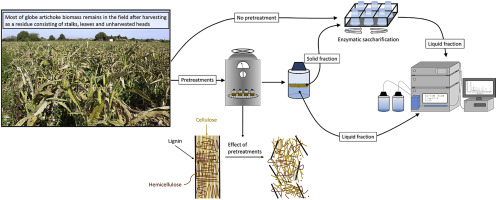Biomass & Bioenergy ( IF 6 ) Pub Date : 2020-02-04 , DOI: 10.1016/j.biombioe.2020.105471 Gaetano Roberto Pesce , Maria C. Fernandes , Giovanni Mauromicale

|
The globe artichoke [Cynara cardunculus var. scolymus (L.) Fiori] produces large amounts of residues after harvesting. Such biomass could be exploited for energy purposes and, for obvious reasons, does not compete with food production. In this work, the production of residues from the cultivars Apollo and Violetto di Sicilia, grown in Ramacca (Sicily), and from the cultivar Spinoso sardo, grown in Siracusa (Sicily), has been evaluated over a two year period. The average biomass productivity of crop residues from the different globe artichoke varieties assessed in this study is around 11 t dry matter (DM) per hectare per year. This is a considerable figure, especially considering there are more than 14,000 ha cultivated with globe artichoke in Sicily.
For ‘Spinoso sardo’, an evaluation of sugar production, for potential ethanolic fermentation, was carried out. The biomass has therefore been subjected to various pretreatments with different dilute sulfuric acid solutions (0, 0.5 and 2%), in order to break up its lignocellulosic structure. The responses of biomass to the dilute acid hydrolysis (DAH) were evaluated by the saccharification yield of the pretreated solids. Results show that, with the harshest conditions of this experiment (H2SO4 2% and 121 °C for 1 h), up to ~440 kg of fermentable sugars (glucose and xylose) per ton of DM are obtainable from ‘Spinoso sardo’ pretreated biomass. The same pretreatment resulted in a theoretical production of bioethanol per hectare of ~3,900 kg.
中文翻译:

朝鲜蓟农作物残留及其通过稀酸水解产生生物乙醇的潜力
朝鲜蓟[ Cynara cardunculus var。收割后山楂(L.)Fiori]产生大量残留物。可以将这种生物质用于能源目的,并且由于显而易见的原因,不会与粮食生产竞争。在这项工作中,在两年的时间里,评估了在拉马卡(西西里)种植的Apollo和Violetto di Sicilia品种以及在西拉库萨(Siracusa)种植的Spinoso sardo品种的残留量。在这项研究中评估的不同朝鲜蓟品种的农作物残渣的平均生物量生产力为每公顷每年约11吨干物质(DM)。这是一个可观的数字,尤其是考虑到西西里岛有超过14,000公顷的朝鲜蓟种植面积。
对于“ Spinoso sardo”,对可能的乙醇发酵的糖产量进行了评估。因此,为了破坏其木质纤维素结构,已经用不同的稀硫酸溶液(0%,0.5%和2%)对生物质进行了各种预处理。通过预处理后的固体的糖化收率评估了生物质对稀酸水解(DAH)的响应。结果表明,在该实验的最苛刻条件下(H 2 SO 4 2%和121°C持续1 h),每吨DM可获得约440 kg可发酵糖(葡萄糖和木糖),从'Spinoso sardo预处理的生物质。相同的预处理导致每公顷约3,900公斤的生物乙醇理论产量。



























 京公网安备 11010802027423号
京公网安备 11010802027423号